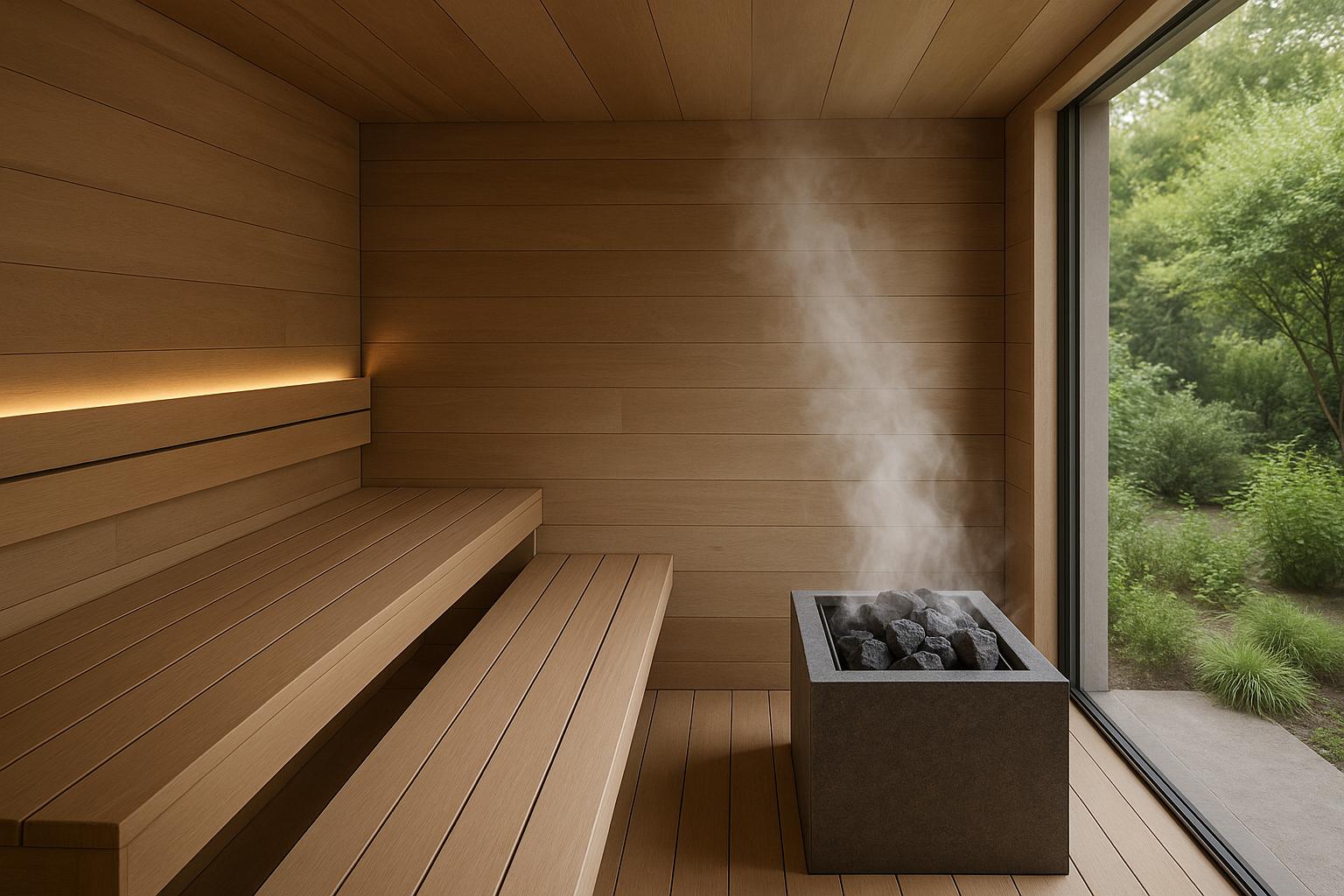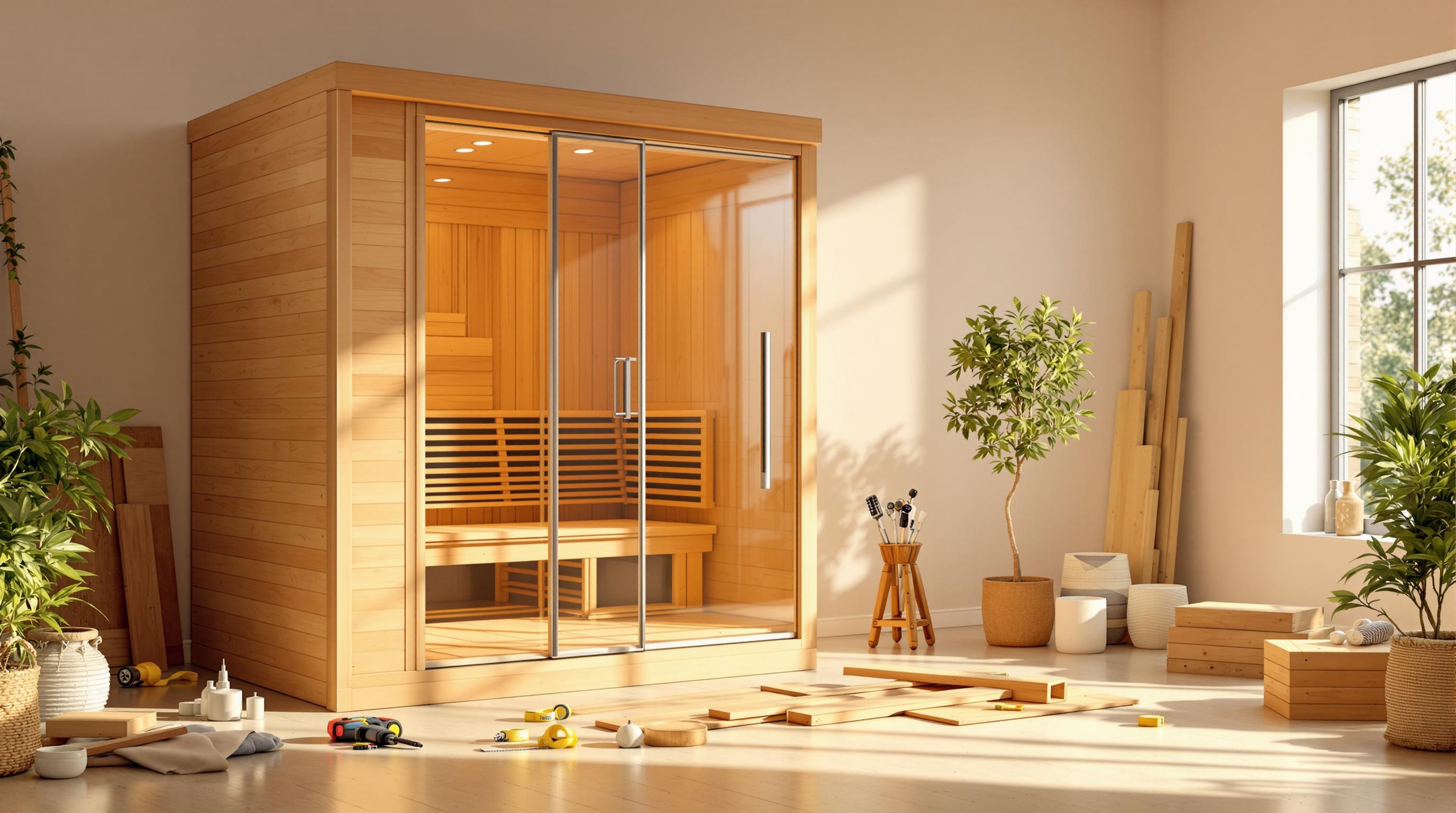Choosing the right sauna for your home depends heavily on your ceiling height. Infrared saunas and steam saunas have very different requirements due to how they generate and distribute heat. Here’s a quick breakdown:
- Infrared saunas: Work with lower ceilings since they use radiant panels to heat your body directly. They’re ideal for spaces with standard residential ceiling heights and offer flexibility for smaller rooms.
- Steam saunas: Require ceilings between 7 and 8 feet for proper steam circulation. Higher ceilings can reduce efficiency and increase energy use.
For homes with limited vertical space, infrared saunas are often the better choice. Steam saunas, however, provide a more traditional experience but need precise ceiling height and bench placement to function effectively.
Quick Comparison:
| Aspect | Infrared Saunas | Steam Saunas |
|---|---|---|
| Ceiling Height | Flexible, no strict limit | 7–8 feet optimal |
| Heat Distribution | Direct radiant heat | Convection-based circulation |
| Energy Efficiency | Unaffected by height | Decreases with higher ceilings |
| Installation Flexibility | High | Limited by ceiling height |
| Bench Clearance | 36 inches above top bench | 44–48 inches above top bench |
If your space has lower ceilings, go for an infrared sauna. For a steam sauna, ensure your room meets the height requirements for the best experience.
Infrared Sauna Ceiling Height Requirements
Standard Ceiling Height Range for Infrared Saunas
Infrared saunas are a great fit for homes with typical residential ceiling heights. Unlike some other types of saunas, they don’t need a lot of vertical space to operate effectively. This makes them an excellent option for most home setups, as they work seamlessly within standard ceiling dimensions.
Why Infrared Saunas Work with Lower Ceilings
What sets infrared saunas apart is how they heat the body. They use radiant panels to warm you directly, rather than relying on heating the air around you. This method means they don’t require the high ceilings that traditional saunas often need for proper air circulation. In fact, lower ceilings can help create a snug, energy-efficient environment by reducing the space that needs to be heated and minimizing heat loss. It's a win-win for both comfort and efficiency.
Small Space Installation Benefits
Another advantage of infrared saunas is their adaptability. They can fit into smaller or uniquely shaped spaces without much hassle. Their minimal need for vertical clearance makes them an ideal choice for homes with limited room, allowing for simple installation even in tighter areas.
Steam Sauna Ceiling Height Requirements
Recommended Ceiling Height Range for Steam Saunas
For steam saunas, keeping the ceiling height within 96 inches (8 feet) or less is ideal. This height strikes a balance between efficient steam circulation and energy use, ensuring the sauna operates effectively without wasting resources.
Why Steam Circulation Needs Headroom
Steam saunas rely heavily on air circulation to distribute heat. Unlike infrared saunas, which directly heat the body, steam saunas warm the surrounding air by boiling water to create steam. This process depends on convection, where warm steam rises and circulates throughout the room to provide consistent heat. Without proper headroom, this heat distribution becomes uneven, making the sauna less effective at maintaining a comfortable and balanced environment.
Problems with Overly High Ceilings
When ceilings are too high, it disrupts the delicate balance needed for efficient operation. Higher ceilings increase the room's overall volume, leading to uneven temperatures, slower warm-up times, and the need for a more powerful generator. This not only drives up energy costs but also reduces the sauna's overall efficiency.
What to Look for When Buying or Building a Sauna
sbb-itb-3953eb0
Infrared vs. Steam: Ceiling Height Comparison
Infrared and steam saunas have different heating methods, which means they require distinct ceiling height considerations. This difference often makes infrared saunas a better fit for smaller spaces, as they use direct radiant heat. This type of heating allows for flexibility with ceiling heights, making them suitable for rooms with limited headroom.
Steam saunas, on the other hand, depend on proper air circulation for even heat distribution. To achieve this, they generally work best with ceilings between 84 inches (7 feet) and 96 inches (8 feet). For example, Finlandia Sauna recommends a 7-foot ceiling, while Harvia advises keeping ceilings no higher than 90 inches (7 feet 6 inches) for optimal efficiency and comfort.
Here’s a quick comparison of the two:
| Aspect | Infrared Saunas | Steam Saunas |
|---|---|---|
| Minimum Height | No strict requirement | 6 feet 5 inches (77 inches) |
| Optimal Range | Flexible – based on space | 7–7.5 feet (84–90 inches) |
| Maximum Recommended | No specific limit | 8 feet (96 inches) |
| Heat Distribution | Direct radiant heat | Convection-based circulation |
| Energy Efficiency | Unaffected by ceiling height | Decreases with higher ceilings |
| Installation Flexibility | High – fits various spaces | Limited due to air circulation needs |
| Comfort Consideration | Panel positioning is crucial | 44 inches (112 cm) clearance above the upper bench is key |
Steam saunas lose efficiency when ceilings exceed 8 feet, while infrared saunas maintain consistent energy use regardless of height. Comfort in steam saunas also requires about 44 inches (112 cm) of clearance above the upper bench. This ensures users can access the warmest air layer without feeling cramped. Infrared saunas, however, focus on proper placement of heating panels to ensure effective heat delivery to the body.
When installing a steam sauna, overly high ceilings can create what’s known as the "Bleacher Effect." This happens when multiple bench levels are needed to reach the warmer air, making entry and exit more difficult and less safe. To address this, adding a drop ceiling can help bring the space into the optimal range for better efficiency and comfort.
Bench Placement and Clearance Guidelines
The placement of benches in a sauna is just as important as the ceiling height when it comes to creating an efficient and enjoyable experience. Whether you’re using an infrared or steam sauna, the spacing of benches plays a major role - infrared saunas focus on direct radiant heat, while steam saunas thrive on proper air circulation.
Bench Height Recommendations for Infrared and Steam Saunas
In steam saunas, the upper bench should be positioned 44 to 46 inches below the ceiling. This ensures you’re seated in the ideal heat zone for maximum warmth and comfort.
Infrared saunas, on the other hand, are a bit more flexible. Since the heat comes directly from the panels instead of rising air, the bench height isn’t as strict. Still, a minimum clearance of 36 inches is recommended to provide enough headroom for comfortable seating and movement.
The main difference lies in how the heat is delivered. Steam saunas depend on rising heat, creating warmer layers higher up, which makes precise bench placement essential. Infrared saunas, however, offer consistent, direct heat regardless of bench height.
Clearance Above Benches for Comfort and Efficiency
To ensure comfort and proper heat distribution, maintain at least 36 inches of clearance above the top bench. This spacing keeps users in the primary heat zone for an optimal experience.
For steam saunas, a clearance of 44 to 48 inches is ideal. This extra space helps improve airflow around your head, preventing the uncomfortable sensation of having a "hot head and cold feet". Proper clearance also keeps the heat and steam concentrated where it’s needed most - around the seating area - allowing you to fully enjoy the benefits of your sauna session.
Choosing the Right Ceiling Height for Your Home Sauna
When planning your home sauna, ceiling height plays a big role in how well your sauna performs and how comfortable it feels. The type of sauna you choose - infrared or steam - will largely dictate how much vertical space you need for the best results. This connection between ceiling height and bench placement ties directly to the design elements discussed earlier.
Infrared saunas are a great option if you're working with standard residential ceiling heights. Thanks to their direct radiant heat technology, they don't rely on extra vertical space for heat circulation. This makes them particularly well-suited for basements or rooms with lower ceilings.
Steam saunas, on the other hand, typically need higher ceilings. The extra height allows steam to rise and flow naturally, ensuring even heat distribution and a consistent temperature throughout the cabin. Without this headroom, the steam experience may feel uneven or less effective.
Another important factor is bench placement. Proper clearance between benches and the ceiling creates an ideal heat zone, making your sauna sessions more enjoyable and effective.
So, take a close look at your available space. If your room has lower ceilings, an infrared sauna is likely your best bet. However, if you're aiming for the classic steam sauna experience, make sure your space has the necessary vertical clearance.
Matching your ceiling height with the right sauna type will improve both performance and comfort. Whether you're exploring pre-made options or planning a custom build, choosing the right fit for your space will ensure years of relaxing and efficient sauna sessions.
FAQs
How does ceiling height affect the energy efficiency of steam and infrared saunas?
Ceiling height is a key factor in determining the energy efficiency of both steam and infrared saunas.
For steam saunas, a ceiling height of about 7 feet works best. This height helps contain the heat efficiently, cutting down on energy use by reducing heat loss. With lower ceilings, the sauna warms up faster and maintains steady temperatures with less energy.
When it comes to infrared saunas, there’s a bit more leeway. Ceilings between 6.5 and 8 feet are ideal, ensuring even heat distribution and a comfortable environment. Unlike steam saunas, slightly higher ceilings don’t affect efficiency much because infrared heat is absorbed directly by the body rather than heating the air.
Selecting the right ceiling height based on your sauna type can help you use energy wisely while also improving your sauna experience.
What happens if you install a steam sauna in a room with ceilings taller than 8 feet?
Installing a steam sauna in a room with ceilings taller than 8 feet can affect its performance and energy efficiency. Higher ceilings allow heat to rise and spread out, making it more challenging to maintain steady, comfortable temperatures. This often results in uneven heat distribution, reducing the sauna's overall effectiveness and comfort.
To get the most out of a steam sauna, a ceiling height of 7 to 8 feet is typically recommended. This height helps trap heat more effectively, ensures a more consistent temperature, and keeps the sauna running as designed. If the ceiling is higher, additional energy may be needed to offset the heat loss, which could lead to increased operating costs.
Are infrared saunas a good option for spaces with unusual or irregular layouts?
Infrared saunas are a great option for spaces with unusual or irregular layouts. Thanks to their modular designs and customizable shapes, they can easily fit into non-standard areas. Unlike traditional steam saunas, infrared models typically take up less space and work well in rooms with lower ceilings or unconventional configurations, making them a practical choice for many different home setups.


